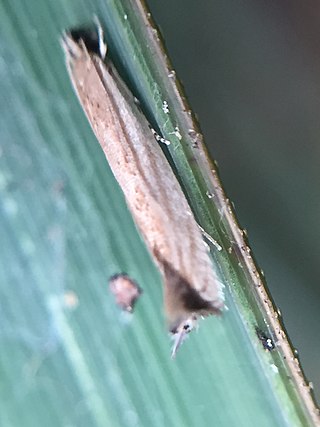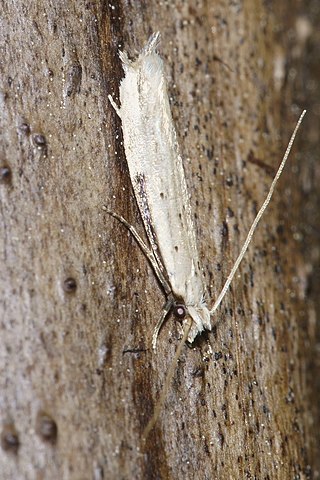
Eschatotypa is a genus of moths belonging to the family Tineidae.

Eugennaea is a genus of moths belonging to the family Tineidae. It was described in 1914 by Edward Meyrick. The genus contains only one species, Eugennaea laquearia, which is endemic to New Zealand. Meyrick described the species from specimens collected by George Vernon Hudson on Nīkau stems at Kaeo in January.

Erechthias chionodira is a species of moth in the family Tineidae. It was described by Edward Meyrick in 1880 using two specimens obtained in Auckland on a shady bank amongst forest in January. This species is endemic to New Zealand.

Heterocrossa epomiana is a species moth in the family Carposinidae. It is endemic to New Zealand and has been observed in Westland. Adults are on the wing in January. This species is visually very similar to H. gonosemana and to H. philpotti.

Heterocrossa exochana is a species of moth in the family Carposinidae. It is endemic to New Zealand and has been observed in the North and South Islands. The larvae of this species feed on the fruits of Muehlenbeckia species. The adult is on the wing from September until May and are attracted to light.

Glyphipterix achlyoessa, commonly known as the cocksfoot stem borer, is a species of moth in the family Glyphipterigidae. It is endemic to New Zealand and can be found throughout the country. This species inhabits meadows and open grasslands. The larvae are hosted by species in the genus Juncus as well as by the species Dactylis glomerata. Adult moths are commonly on the wing from October to December.

Stathmopoda skelloni, the yellow featherfoot, is a species of moth in the Stathmopodidae family. It is endemic to New Zealand and can be found throughout the country. This species inhabits native forest, coastal dunes and shrubland as well as cultivated gardens and orchards. The larvae of this species feed on a variety of plant species including agricultural crops such as kiwifruit and persimmons. The adult moths are on the wing from September until March and are nocturnal but are attracted to light.

Archyala pentazyga is a species of moth in the family Tineidae. It was described by Edward Meyrick in 1915 using a specimen provided by George Vernon Hudson. Hudson collected the specimen at Days Bay in Wellington in January. It is endemic to New Zealand.

Astrogenes chrysograpta, is a species of moth in the family Tineidae. It was described by Edward Meyrick in 1921 using a specimen collected by Stella Hudson on Mount Arthur in January. This species is endemic to New Zealand.

Erechthias acrodina is a species of moth in the family Tineidae. It was described by Edward Meyrick in 1912 using a specimen collected by George Vernon Hudson in Wellington. This species is endemic to New Zealand.

Erechthias charadrota is a species of moth in the family Tineidae. It was described by Edward Meyrick in 1880 using three specimens caught in dry forest-scrub near Wellington and Port Lyttelton during the month of January. This species is endemic to New Zealand.

Erechthias chasmatias is a species of moth in the family Tineidae. It was described by Edward Meyrick in 1880 using two male specimens taken in forest in Wellington in January. This species is endemic to New Zealand. It has been found in the Wellington Botanic Garden.

Erechthias crypsimima is a species of moth in the family Tineidae. It was described by Edward Meyrick in 1920 using a specimen collected by George Vernon Hudson in Wellington in February. This species is endemic to New Zealand. Hudson noted that he collected the type specimen of this species from the black trunk of a beech tree.

Erechthias exospila is a species of moth in the family Tineidae. It was described by Edward Meyrick in 1901 using a specimen he collected in Whangārei in December. This species is endemic to New Zealand.

Erechthias hemiclistra is a species of moth in the family Tineidae. It was described by Edward Meyrick in 1911. This species is endemic to New Zealand. Entomologist George Hudson reared this moth from caterpillars and cocoons in the flower stems of Chionochloa conspicua at Makara. The adults emerged in November and February. The food of the larvae of this species is apparently dead woody fibre.

Erechthias macrozyga is a species of moth in the family Tineidae. It was described by Edward Meyrick in 1916. This species is endemic to New Zealand. The holotype specimen of this species was collected at Tisbury, Invercargill by Alfred Philpott.

Eschatotypa derogatella is a species of moth in the family Tineidae. It was described by Francis Walker in 1863. This species is endemic to New Zealand.

Eschatotypa halosparta, also known as the salt and pepper fungus moth, is a species of moth in the family Tineidae. It was described by Edward Meyrick in 1919 from a specimen collected by George Vernon Hudson at Wainuiomata in December. This species is endemic to New Zealand. This species has also been collected near the Tui Mine in Te Aroha.

Lysiphragma epixyla is a species of moth in the family Tineidae. It is endemic to New Zealand. It was described by Edward Meyrick in 1888 using specimens collected from Wellington, Lake Wakatipu and Invercargill in December and January. Meyrick notes that this moth can usually be found at rest on tree trunks. This species is endemic to New Zealand.

Sagephora steropastis is a species of moth in the family Tineidae. It was described by Edward Meyrick in 1891. This species is endemic to New Zealand.






















